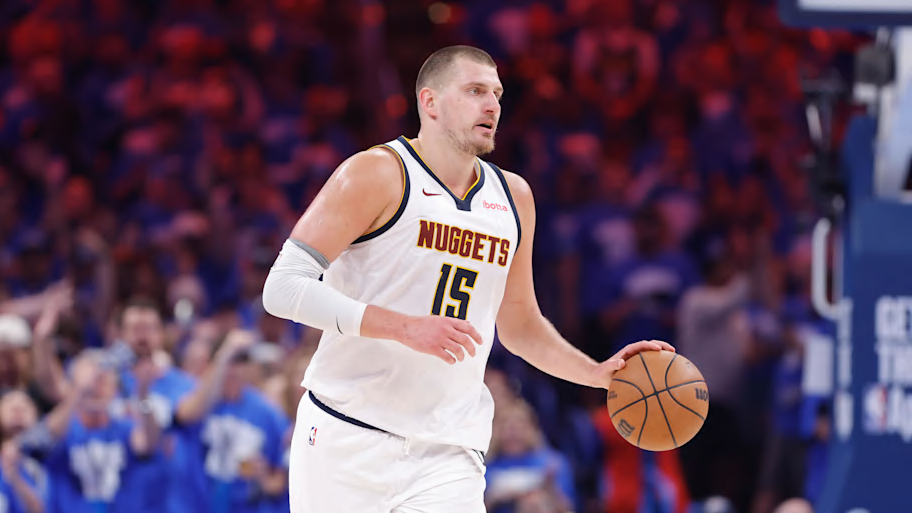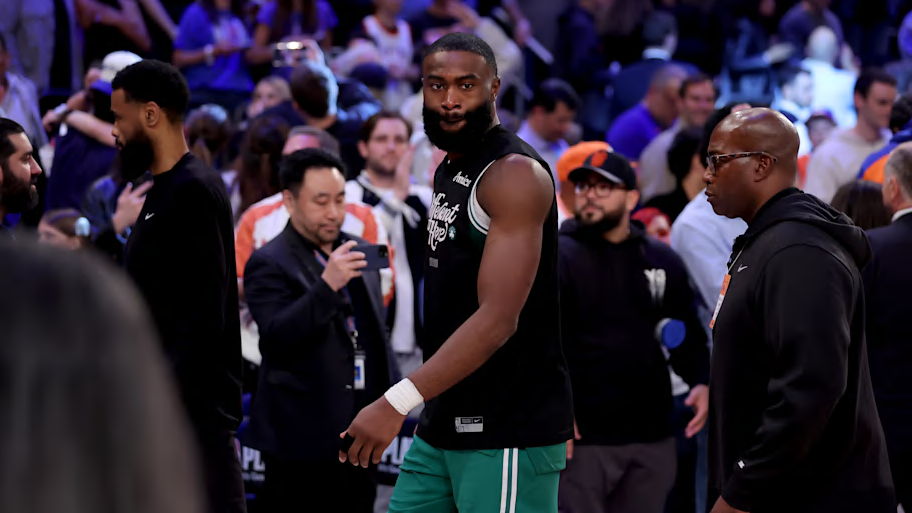The second round of this year’s NBA playoffs was, unfortunately, defined by injuries.
In each of the four conference semifinals series, one of the two participating teams suffered an injury to a major contributor. Stephen Curry went down in Game 1 of the Golden State Warriors–Minnesota Timberwolves series with a hamstring strain. Evan Mobley and De’Andre Hunter joined the already hurt Darius Garland on the injury list in Game 2 of the Cleveland Cavaliers–Indiana Pacers bout. Jayson Tatum, of course, tore his Achilles tendon in Game 3 of the Boston Celtics–New York Knicks matchup. And then, to put a depressing cap on it all, Aaron Gordon tweaked his hamstring late in Game 6 and was clearly not healthy for Game 7 of the Denver Nuggets–Oklahoma City Thunder clash. All four teams whose stars suffered injuries lost, while their healthy opponents moved on.
Such injuries can muddy the waters when trying to pinpoint what went wrong for the eliminated teams and how they can use the disappointing outcome to continue to build. On the other hand, they can exacerbate what were already weak links on a roster and force teams to face a reality they would have preferred to hide from otherwise.
Regardless of how rocky the road, the end result was the same: four teams eliminated from postseason contention. As was the case with the eight teams eliminated in the first round, these organizations will have plenty to reflect on as their offseasons get underway.
Here’s one lesson each team learned on their way out of the second round.
Boston Celtics
Lesson learned: The consequences of attrition can strike at any time
The Celtics have been extremely competitive for pretty much all of Tatum and Jaylen Brown’s respective careers. Since teaming up in 2017, when Tatum was taken with the third pick in the draft, Boston has been to five conference finals and two NBA Finals. Consistently contending for a championship like that is great for everybody involved, from the fans to the players all the way up to the C-suite.
There are consequences, though. Consequences that can strike at the absolute worst time, as the Celtics learned the hard way. Tatum tore his Achilles in Game 3 of the Knicks series (effectively ending the Celtics’ season) and it was revealed afterward Brown was battling a partial meniscus tear throughout the second half of the season.
In the last five years, the two stars have combined to play 684 regular season games. Entering this postseason, they had played in 85 postseason games since 2020. Tatum played in multiple Olympics and Brown joined him for a FIBA run in ’19. Those are signs of remarkable consistency, durability and success. But it’s hard to overstate how much wear and tear it puts on a body, even professional athletes in their physical primes. For any player not named LeBron James, eventually something happens; a muscle tears or a ligament snaps, a bone fractures.
This was the year that something happened to Boston’s stars. Tatum’s reputation as the NBA’s iron man finally caught up to him. Brown’s relentlessly physical, above-the-rim style of play finally caught up to him. For all those who preach that availability is the best ability, it comes with a cost. The number of minutes, the physicality, the constant leaping and landing, it grinds away on the body until something gives.
This is something every team knows. The Celtics learned how much it can hurt for that bill to arrive.
Cleveland Cavaliers
Lesson learned: Evan Mobley still has a long way to go
The Cavs losing in the second round of the Eastern Conference playoffs after winning 64 games in the regular season is an enormous disappointment. There are plenty of reasons for the massive letdown; the injuries mentioned above played a strong role, as did the excellent play of the Pacers. But as far as traits from the series the organization has to keep in mind going forward, it’s tough to look anywhere other than at Mobley.
Mobley had his best season to date in 2024–25, winning the Defensive Player of the Year award while averaging career-high numbers in points, made field goals and made three-pointers per game. Coach Kenny Atkinson successfully figured out how to keep Mobley involved in the offense to complement his already excellent defense. But any hopes Mobley was truly ready to make the leap from a good player to a great one dissipated watching him these playoffs.
Mobley wasn’t bad, per se, for much of Cleveland’s postseason. He just didn’t elevate his game the way true stars are supposed to. For the season, the big man averaged 18.5 ppg on 12.8 field goal attempts per game. In the playoffs, he averaged … 17.1 ppg on 10.9 shots per game. A failure to dominate is one thing, but the wheels came completely off in Round 2 against the Pacers. The Cavs were outscored by 20 points in the All-Star big man’s minutes on the floor in Game 1, where he suffered a sprained ankle late in the contest. In Game 4, the team was outscored by 27 points in Mobley’s 26 minutes; with elimination on the line in Game 5, they were outscored by 14.
Mobley had a great year and will turn 24 in June. His ceiling is still quite high. But the postseason is when stars are supposed to take control, to elevate their numbers as their minutes increase and really make an impact on the flow of the game. Instead, Mobley shrunk. It should serve as a sign that he hasn’t made the star leap quite yet.
Denver Nuggets

Lesson learned: Depth must improve
Nikola Jokic said it himself after the Nuggets got blown out in Game 7 against the Thunder to get sent home: Denver needs better depth to compete with the best of the best in today’s NBA. It’s been a clear weak spot since the team brought home its first title in 2023, but at this stage the roster has been watered down enough that it must be addressed.
Part of the urgency is that, for all the valid concerns during the regular season, the Nuggets’ Big 3 is still excellent come playoff time. Three-man lineups featuring Jokic, Jamal Murray and Gordon posted a net rating of 8.9 this playoffs. The trio outscored opponents by an average of 6.4 points in their 30.1 minutes per game on the floor together. Murray, in particular, put many questions to bed by yet again elevating his game when it mattered most following something of a rough season by his standards. The main ingredients of the championship formula remain fresh: Jokic’s all-around greatness, Murray’s consistent production and Gordon’s clutch two-way play make for winning basketball.
The problem is that two other players have to be on the floor with them, and Denver is finding it awfully difficult to find the right pieces. Christian Braun and Michael Porter Jr. can prove helpful on the right nights (the former had a much better playoff run than the latter), but after that? It’s truly anybody’s guess. Russell Westbrook had great games and disastrous games in equal measure. Julian Strawther showed up in Game 6 against the Thunder and didn’t hit the double-digit point mark in any of the other playoff games he appeared in. Peyton Watson’s inability to threaten defenses with his shooting mostly offset whatever chaos he caused defensively. On perfect nights, all those bench pieces worked in tandem, but perfect nights are rare in the NBA. The Nuggets had almost zero margin for error otherwise.
Every championship contender wants more shooting, defending and playmaking off the bench. The Nuggets are not unique in that regard. But given they have zero players outside the starting five who can do even two of those three things consistently is a problem and served as the death knell for this year’s title hopes.
Golden State Warriors
Lesson learned: More moves must be made to maximize Jimmy Butler
The big lesson from the Warriors’ gentlemen’s sweep at the hands of the Timberwolves was simple: They will not win without Curry. But we knew that already. The next lesson to be learned? More change must be made to the roster in order to get the best out of Butler.
As fun as it was, Golden State’s 23–8 record after landing Butler at the trade deadline was always a bit of a mirage. The sheer talent differential between the Curry/Butler duo and the other team’s top two players meant the Dubs always had a good chance to win every night, but they were playing with an unfinished roster, choosing to blow up the rotation in exchange for the Miami Heat star. It’s not a move anyone in the Bay Area regrets, but the team that entered the playoffs was not built to maximize anybody’s strengths. It was a hodgepodge of unproven young players and veterans capable of impacting only one side of the floor. That combination plus Curry’s greatness was good enough to beat an inexperienced Houston Rockets team in the first round. But once Curry went down, the holes on the team became glaring.
Butler did what he could to elevate his game without his superstar teammate, increasing his postseason points per game average to 20.3 from 18.6 after Curry got hurt. But the clunky fit on the court was obvious. The Warriors had an offensive rating of 101.1 with Butler and Draymond Green sharing the court together, which would rank far below the league-worst Washington Wizards’ 105.8 offensive rating over a full season. Both stars obviously have their flaws offensively, but their collective IQ and experience should never result in an offense worse than a lottery team’s production; the problem instead lies with the players around them.
The Warriors don’t have to gut the entire roster, but a strong makeover is needed. More shooting needs to be on the floor for Butler and Green to survive the cramped spacing their game brings. There can’t be any players like Jonathan Kuminga whose skill set overlaps almost completely with Butler. It’s impossible to replace Curry, but a steady, experienced guard to keep Steve Kerr’s offense would do wonders in taking the load off the star.
Golden State made the big move to land Butler and his greatness for the next few seasons. Now it’s time to reconfigure the roster around the two-headed monster of him and Curry, a task that seems far more important after the Wolves series showed their talent alone isn’t enough.
This article was originally published on www.si.com as Team Lessons From Second-Round NBA Playoff Eliminations.
